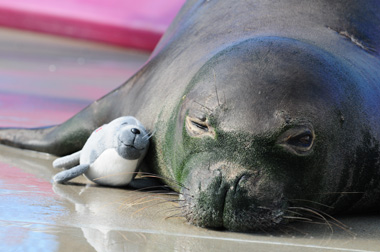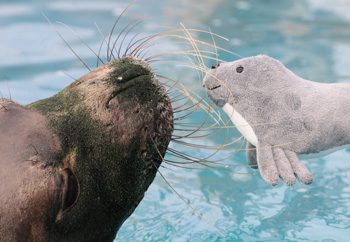Campus News
Hawaiian monk seal toy raises funds to save endangered species
A UCSC marine biologist offers cuddly “Real Seal” toys, one for each of the 1,100 Hawaiian monk seals left in the world.


For that special Christmas gift, how about saving an endangered species? That’s the goal of the Real Seal, a 6-inch plush Hawaiian monk seal toy designed by monk seal researchers at the University of California, Santa Cruz. Each toy seal is tagged with a unique NOAA identification number for a wild seal living in the Hawaiian Islands.
“The person buying the toy is sponsoring the real seal swimming in the wild, and they are the sole sponsor for their seal, supporting research to help save the species,” said marine biologist Terrie Williams, a professor of ecology and evolutionary biology at UC Santa Cruz.
Williams said she came up with the idea for the toy in response to cuts in federal funding for Hawaiian monk seal research and education efforts. The cuts come at a critical time in the trajectory of the Hawaiian monk seal population, she said. “Currently, it is teetering at 1,100 animals left in the wild, and the species is expected to go extinct in the next 50 years if things do not change. That’s within the lifetime of our newest generation of young marine biologists,” Williams said.
The Real Seal project aims to raise awareness for the species, increase the involvement of the general public, and help provide some funds for basic research that can help efforts to bring the species back from the brink of extinction. The Real Seal is only available from the project’s web site at www.savemonkseals.ucsc.edu. Only 1,100 of the toys, one for each wild Hawaiian monk seal, are available.
To purchase a Real Seal, the sponsor will need to donate $39.95 to support the monk seal research program and will also have to describe a conservation action they will take on behalf of Hawaiian monk seals and the oceans. The web site offers examples of possible actions, such as beach clean-ups, writing to federal legislators, and giving a seal to a budding marine biologist. In addition to the toy, sponsors get access to detailed information about their sponsored seal on the project web site, including age, sex, year of birth, and island home location. The web site also provides conservation information, education plans for teachers, and a listing of other sponsors with their Real Seal ID numbers and conservation ideas.
In her research on Hawaiian monk seals, Williams works closely with biologists at the National Marine Fisheries Service (NMFS, part of the National Oceanic and Atmospheric Administration), which is the federal agency responsible for marine mammals in U.S. waters. For the Real Seal project, NMFS scientists provided the identification numbers and basic information about each seal from their files. To pay for the toys and set up the web site, which went live on December 6, Williams used profits from a book she wrote about her work with the seals (The Odyssey of KP2: An Orphan Seal, a Marine Biologist, and the Fight to Save a Species).
“I was working on an education program for teachers, so that we could extend our reach beyond the school groups that are able to visit our lab, and I submitted a proposal for funding. But after the sequester, of course, NMFS didn’t have any money for that, so I took the profits from the book and put it into the education program,” Williams said. “The idea for the toy came from wanting to give kids something they can touch and see to connect with the seals.”
Currently, the NMFS program for Hawaiian monk seals barely has enough funding to carry out population counts, she said. She hopes to raise enough money to pay for a “critter cam” and other monitoring equipment that can be used to record and study the behavior of monk seals in the wild. A “critter cam” is a small, waterproof video camera that can be attached harmlessly to a seal’s head and later recovered. Williams has used this technology to study other species in the wild, in conjunction with her laboratory studies of marine mammal physiology carried out at UCSC’s Long Marine Laboratory.
Two Hawaiian monk seals–first KP2 and now KE18–have participated in her research program at Long Marine Lab, providing valuable information about monk seal physiology. Combining that data with detailed observations of monk seal behavior in the wild will help scientists identify the ideal habitat for Hawaiian monk seals and the best places to focus conservation efforts to avoid conflicts between humans and seals.
“The cameras and instruments we want are critical. If we sell all the seal toys, we can buy the instruments, and if it’s a smaller amount it will support our ongoing work at the lab,” Williams said. “We would love to see classrooms, scout troops, and other kids groups get involved by using their Real Seal as a mascot. I consider it the ultimate Christmas gift–imagine saving an endangered species instead of buying another tie or app download.”